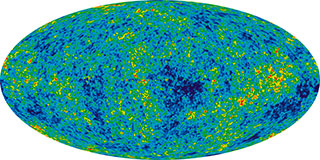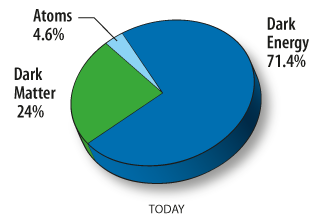
WMAP PRODUCES NEW RESULTS
WMAP 9-year Results Released
WMAP has refined its measurements with a final 2 years of data.
The WMAP science team has determined, to a high degree of accuracy and precision, not only the age of the universe, but also the density of atoms; the density of all other non-atomic matter; the epoch when the first stars started to shine; the "lumpiness" of the universe, and how that "lumpiness" depends on scale size. In short, when used alone (with no other measurements), WMAP observations have improved knowledge of these six numbers by a total factor of 68,000, thereby converting cosmology from a field of wild speculation to a precision science.
WMAP's "baby picture of the universe" maps the afterglow of the hot, young universe at a time when it was only 375,000 years old, when it was a tiny fraction of its current age of 13.77 billion years. The patterns in this baby picture were used to limit what could have possibly happened earlier, and what happened in the billions of year since that early time. The (mis-named) "big bang" framework of cosmology, which posits that the young universe was hot and dense, and has been expanding and cooling ever since, is now solidly supported, according to WMAP.
WMAP observations also support an add-on to the big bang framework to account for the earliest moments of the universe. Called "inflation," the theory says that the universe underwent a dramatic early period of expansion, growing by more than a trillion trillion-fold in less than a trillionth of a trillionth of a second. Tiny fluctuations were generated during this expansion that eventually grew to form galaxies.
Remarkably, WMAP's precision measurement of the properties of the fluctuations has confirmed specific predictions of the simplest version of inflation: the fluctuations follow a bell curve with the same properties across the sky, and there are equal numbers of hot and cold spots on the map. WMAP also confirms the predictions that the amplitude of the variations in the density of the universe on big scales should be slightly larger than smaller scales, and that the universe should obey the rules of Euclidean geometry so the sum of the interior angles of a triangle add to 180 degrees.
The universe comprises only 4.6% atoms. A much greater fraction, 24% of the universe, is a different kind of matter that has gravity but does not emit any light --- called "dark matter". The biggest fraction of the current composition of the universe, 71%, is a source of anti-gravity (sometimes called "dark energy") that is driving an acceleration of the expansion of the universe.
WMAP has also provided the timing of epoch when the first stars began to shine, when the universe was about 400 million old. The upcoming James Webb Space Telescope is specifically designed to study that period that has added its signature to the WMAP observations.
WMAP launched on June 30, 2001 and maneuvered to its observing station near the "second Lagrange point" of the Earth-Sun system, a million miles from Earth in the direction opposite the sun. From there, WMAP scanned the heavens, mapping out tiny temperature fluctuations across the full sky. The first results were issued in February 2003, with major updates in 2005, 2007, 2009, 2011, and now this final release. The mission was selected by NASA in 1996, the result of an open competition held in 1995. It was confirmed for development in 1997 and was built and ready for launch only four years later, on-schedule and on-budget.


